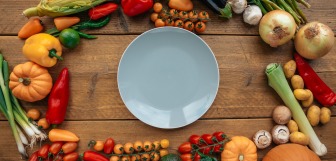How to Use Seasonal Ingredients in Australia
With the exception of extreme climate countries, changes in season bring little more to consumers than outfit adjustments and slightly raised supermarket prices for fruit and veg. For business owners, however, this is far from the case.
Using seasonal produce opens an opportunity for eateries to provide a higher quality food offering, get creative with the menu and most importantly, keep costs down.
However, though these benefits definitely do exist, using seasonal ingredients correctly can be tricky for restauranters as you need to be hot on what's in season, as well as how to use it.
So if you're struggling to pick your produce don't worry, we're on hand to help! From business benefits to menu ideas, our comprehensive ingredients guide can help you make the most of Australian seasonal produce, no matter the time of year.
What is seasonal produce?
Seasonal produce refers to ingredients that are grown and harvested during a particular time of year and usually corresponds to the conditions in which they grow best. Since climate dictates the seasonality of fruit and veg, what might be considered seasonal in one country may not be the same in another.
Seasonal food in Australia is no different - For example, strawberries are typically in season from late September through to early December, whereas in Spain they're at their best from May through to June.
How can your business benefit from using seasonal ingredients?
Using seasonal produce means your business is getting the best quality produce available. While it may take a little more consideration, there are numerous benefits to using seasonal ingredients in your eatery, including:
Increased customer satisfaction
It's rule of thumb that seasonal produce is typically fresher and of a higher quality than its non-seasonal counterparts. Since they're picked at peak ripeness, these ingredients are far fresher and tastier than produce that has spent weeks in transit, making for better quality meals and increased customer satisfaction overall.
Reduced costs
Seasonal produce is typically cheaper than non-seasonal produce, as it's more readily available. This is due to the fact that more seasonal produce is being grown overall, so there's technically more of it to go around. This higher level of abundance also puts downward pressure on prices, so you can provide better quality meals whilst also pushing your profits.
Extended reach
By using seasonal ingredients you can create dishes that are unique to the time of year, which is a great way to keep your menu fresh and exciting. This is a great way to build up repeat business and extend your restaurant's reach to diners with different taste.
This can help to attract new customers looking for something unique, and keep existing ones coming back for more. If you're a seafood restaurant located in Australia for example, you could use seasonal ingredients like Barramundi, Moreton Bay Bugs and Mud Crab to create special dishes that are only available to diners during certain times of the year.
Raised sustainability status
Since seasonal produce doesn't have to travel as far or be stored for long, it's far better for the environment than ingredients that are out of season, and can help to make your business more sustainable overall. This can be beneficial when seeking investment and also attracts environmentally conscious diners.
When you’re not using seasonal ingredients, our Sustainably Run app can help your business become more sustainable and shows how your restaurant can make a difference to the world. And the best part? - it’s completely free to download from the Epos Now App Store!
Improved reputation
Buying seasonal produce supports both local farmers and the local economy. Helping the community (as well as the environment) with your business can be a key differentiator when customers are comparing you to other restaurants in the area.
Gain all the advantages of an EPOS system with detailed, flexible, downloadable reports, and so much more:
- Manage and update products quickly with easy to use software
- Expand your business into multiple channels and integrate with a variety of online platforms
- Manage multiple locations and salespoints with multi-site management
- Keep queues short with streamlined, modifiable sales processes
- Choose a setup that suits you with software and hardware options

Seasonal food calendar: Australia
Now that we've gone over some of the reasons to use seasonal ingredients, let's take a look at what food is in season in Australia throughout the year:
Spring
Australian spring typically runs from September through to November and is characterized by an abundance of vibrant fruits and vegetables. Some seasonal spring ingredients to look out for in Australia include:
- Asparagus, beans (broad, green), capsicum, cherries, chillies, daikon, watercress, garlic, ginger, lettuce, mangoes, mushrooms, olives, onions (spring), Pepino, radish, rhubarb, silverbeet, snow peas, spinach, strawberries, Witlof.
Summer
Australian summer runs from December through to February and is typified by hot weather and long days. This time of year is perfect for using lighter, fresher ingredients in your dishes, like:
- Cabbage, capsicum, chillies, cucumber, eggplant, grapes, basil (thai), chervil, chives, dill, kaffir lime leaves mint, oregano, parsley, mangoes, melons (watermelon, rockmelon), onions, onions (spring), stone fruit (apricots, nectarines, peaches, plums), strawberries.
Autumn
Australian autumn typically runs from March through to May and sees the weather cooling down and the days growing shorter. This is reflected in the produce that is available during this season, with many hearty, warming ingredients coming into their peak.
- Beans (green), capsicum, chillies, garlic, ginger, grapes, herbs (basil, coriander, dill, mint, oregano, parsley, rosemary, thyme), lettuce, mangoes, olives, potatoes (new), silverbeet, spinach, strawberries
Winter
Australian winter typically runs from June through to August and is typified by cool weather and shorter days. This is the perfect time of year to make use of substantial seasonal produce like:
-
Broccoli, beans (green), Brussels sprouts, cabbage, carrots, cauliflower, celery, fennel, garlic, ginger, leeks, mushrooms, olives, onions (brown).
How to make the most of your seasonal ingredients
While there are many benefits to using seasonal produce, its benefits become redundant if you don't know how to manage and maximise its use. So how exactly can restaurants make the most of it? Here are a few tips:
Plan ahead
One of the best ways to make sure your business actually benefits from any seasonal produce you buy is to plan your menu in advance. This will give you a better idea of what ingredients you'll need and will allow you to make any necessary adjustments to ensure everything's available when you need it.
It can also be beneficial to plan a ghost menu, with any alternatives for seasonal ingredients included, in the event that you run out of said produce or it’s not as readily available due to increased demand.
Know your sources
If you're not growing your own seasonal produce, it's important to know where your ingredients are coming from. Local farmers' markets are a great way to source seasonal produce direct from the growers.
Building strong relationships with these local farmers and growers not only ensures your business gets the best produce for the best price, but also allows you to be kept up to date on what's in season, and when - all while helping your local community.
Get creative
With seasonal produce, it's important to get creative with your dishes. This is the perfect opportunity to experiment with new flavour combinations and recipes that make use of the best seasonal ingredients.
Not only will this allow you to take advantage of what's available, but it also keeps your menu fresh and exciting - perfect for attracting new customers and keeping your regulars coming back for more.
Specialise in ‘specials’
By using seasonal produce in specials, rather than your main menu classics you can ensure more adventurous customers don't become bored with your offering while avoiding any disappointment for diners who always return for the same dish.
Having a specials menu is also an excellent way to upsell, as customers will be more likely to order a dish they know contains seasonal produce that won't be around for long.
Educate your team
If you want your restaurant to make the most of seasonal produce, it's important that your team are on board too. From the front-of-house staff who take orders to the chefs cooking in the kitchen, everyone needs to be aware of what seasonal produce is available, its benefits and how best to use it.
Conducting regular training sessions on seasonal produce is a great way to ensure your team is up-to-date on what's available and can make suggestions to customers accordingly. You could even offer incentives for staff who sell the most seasonal produce or come up with the best seasonal dish.
Incorporate ingredients into marketing
There's no point using seasonal produce if your diners don't know about it! Make sure your customers are aware of the seasonal ingredients you are using in your dishes by incorporating them into your marketing strategy. This could include anything from social media posts and blog articles, to table talkers and blackboards in-restaurant.
Not only will this help to attract new customers, but it will also give your regulars something to look forward to - ensuring they keep coming back for more.
Make use of preserving methods
If you find yourself with an abundance of seasonal produce, don't let it go to waste! There are many preserving methods that will allow you to enjoy seasonal produce all year, helping you avoid supply bottlenecks and associated price hikes. Canning, freezing and drying are all great methods for preserving seasonal produce and can be easily done at home with minimal equipment.
Be flexible
While it's important to have a plan, it's also important to be flexible. Seasonal produce can be unpredictable, so it's important to be able to adapt your menu or have suitable substitutes on hand if certain ingredients aren't available when you need them. This could be anything from replacing one type of fruit with another in a dessert to using a different vegetable in a soup or salad.
Stay in season with Epos Now
At Epos Now, we provide our customers with the tools they need to keep their business fresh all year round. Our teop-of-the-line systems are designed to make things as simple as possible without sacrificing perfect POS power.
If you're interested in hearing how Epos Now could help your business, get in touch with our expert team below.
